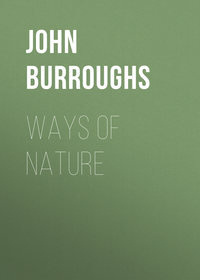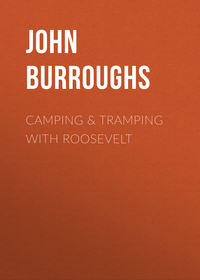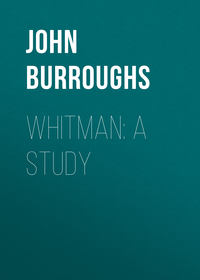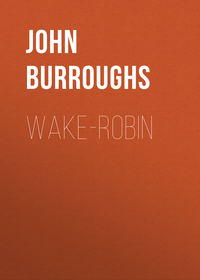 полная версия
полная версияBird Stories from Burroughs
The two older ones showed some signs of fear on our approach, and one of them threw himself upon his back, and put up his impotent legs, and glared at us with open beak. The two smaller ones regarded us not at all. Neither of the parent birds appeared during our stay.
When I visited the nest again, eight or ten days later, the birds were much grown, but of as marked a difference in size as before, and with the same look of extreme old age, – old age in men of the aquiline type, nose and chin coming together, and eyes large and sunken. They now glared upon us with a wild, savage look, and opened their beaks threateningly.
The next week, when my friend visited the nest, the larger of the hawks fought him savagely. But one of the brood, probably the last to hatch, had made but little growth. It appeared to be on the point of starvation. The mother hawk (for the male seemed to have disappeared) had perhaps found her family too large for her, and was deliberately allowing one of the number to perish; or did the larger and stronger young devour all the food before the weaker member could obtain any? Probably this was the case.
Arthur brought the feeble nestling away, and the same day my little boy got it and brought it home, wrapped in a woolen rag. It was clearly a starved bantling. It cried feebly but would not lift up its head.
We first poured some warm milk down its throat, which soon revived it, so that it would swallow small bits of flesh. In a day or two we had it eating ravenously, and its growth became noticeable. Its voice had the sharp whistling character of that of its parents, and was stilled only when the bird was asleep. We made a pen for it, about a yard square, in one end of the study, covering the floor with several thicknesses of newspapers; and here, upon a bit of brown woolen blanket for a nest, the hawk waxed strong day by day. An uglier-looking pet, tested by all the rules we usually apply to such things, would have been hard to find. There he would sit upon his elbows, his helpless feet out in front of him, his great featherless wings touching the floor, and shrilly cry for more food. For a time we gave him water daily from a stylograph-pen filler, but the water he evidently did not need or relish. Fresh meat, and plenty of it, was his demand. And we soon discovered that he liked game, such as mice, squirrels, birds, much better than butcher's meat.
Then began a lively campaign on the part of my little boy against all the vermin and small game in the neighborhood, to keep the hawk supplied. He trapped and he hunted, he enlisted his mates in his service, he even robbed the cats to feed the hawk. His usefulness as a boy of all work was seriously impaired. "Where is J – ?" "Gone after a squirrel for his hawk." And often the day would be half gone before his hunt was successful. The premises were very soon cleared of mice, and the vicinity of chipmunks and squirrels. Farther and farther he was compelled to hunt the surrounding farms and woods to keep up with the demands of the hawk. By the time the hawk was ready to fly, it had consumed twenty-one chipmunks, fourteen red squirrels, sixteen mice, and twelve English sparrows, besides a great deal of butcher's meat.
His plumage very soon began to show itself, crowding off tufts of the down. The quills on his great wings sprouted and grew apace. What a ragged, uncanny appearance he presented! but his look of extreme age gradually became modified. What a lover of the sunlight he was! We would put him out upon the grass in the full blaze of the morning sun, and he would spread his wings and bask in it with the most intense enjoyment. In the nest the young must be exposed to the full power of the midday sun during our first heated terms in June and July, the thermometer often going up to ninety-three or ninety-five degrees, so that sunshine seemed to be a need of his nature. He liked the rain equally well, and when put out in a shower would sit down and take it as if every drop did him good.
His legs developed nearly as slowly as his wings. He could not stand steadily upon them till about ten days before he was ready to fly. The talons were limp and feeble. When we came with food, he would hobble along toward us like the worst kind of a cripple, drooping and moving his wings, and treading upon his legs from the foot back to the elbow, the foot remaining closed and useless. Like a baby learning to stand, he made many trials before he succeeded. He would rise up on his trembling legs only to fall back again.
One day, in the summer-house, I saw him for the first time stand for a moment squarely upon his legs with the feet fully spread beneath them. He looked about him as if the world suddenly wore a new aspect.
His plumage now grew quite rapidly. One red squirrel a day, chopped fine with an axe, was his ration. He began to hold his game with his foot while he tore it. The study was full of his shed down. His dark-brown mottled plumage began to grow beautiful. The wings drooped a little, but gradually he got control of them, and held them in place.
It was now the 20th of July, and the hawk was about five weeks old. In a day or two he was walking or jumping about the grounds. He chose a position under the edge of a Norway spruce, where he would sit for hours dozing, or looking out upon the landscape. When we brought him game, he would advance to meet us with wings slightly lifted, and uttering a shrill cry. Toss him a mouse or sparrow, and he would seize it with one foot and hop off to his cover, where he would bend above it, spread his plumage, look this way and that, uttering all the time the most exultant and satisfied chuckle.
About this time he began to practice striking with his talons, as an Indian boy might begin practicing with his bow and arrow. He would strike at a dry leaf in the grass, or at a fallen apple, or at some imaginary object. He was learning the use of his weapons. His wings also, – he seemed to feel them sprouting from his shoulders. He would lift them straight up and hold them expanded, and they would seem to quiver with excitement. Every hour in the day he would do this. The pressure was beginning to centre there. Then he would strike playfully at a leaf or a bit of wood, and keep his wings lifted.
The next step was to spring into the air and beat his wings. He seemed now to be thinking entirely of his wings. They itched to be put to use.
A day or two later he would leap and fly several feet. A pile of brush ten or twelve feet below the bank was easily reached. Here he would perch in true hawk fashion, to the bewilderment and scandal of all the robins and catbirds in the vicinity. Here he would dart his eye in all directions, turning his head over and glancing up into the sky.
He was now a lovely creature, fully fledged, and as tame as a kitten. But he was not a bit like a kitten in one respect, – he could not bear to have you stroke or even touch his plumage. He had a horror of your hand, as if it would hopelessly defile him. But he would perch upon it, and allow you to carry him about. If a dog or cat appeared, he was ready to give battle instantly. He rushed up to a little dog one day, and struck him with his foot savagely. He was afraid of strangers, and of any unusual object.
The last week in July he began to fly quite freely, and it was necessary to clip one of his wings. As the clipping embraced only the ends of his primaries, he soon overcame the difficulty, and, by carrying his broad, long tail more on that side, flew with considerable ease. He made longer and longer excursions into the surrounding fields and vineyards, and did not always return. On such occasions we would go to find him and fetch him back.
Late one rainy afternoon he flew away into the vineyard, and when, an hour later, I went after him, he could not be found, and we never saw him again. We hoped hunger would soon drive him back, but we have had no clew to him from that day to this.
THE WINTER WREN
An old hemlock wood at the head waters of the Delaware is a chosen haunt of the winter wren. His voice fills these dim aisles, as if aided by some marvelous sounding-board. Indeed, his song is very strong for so small a bird, and unites in a remarkable degree brilliancy and plaintiveness. I think of a tremulous, vibrating tongue of silver. You may know it is the song of a wren from its gushing, lyrical character; but you must needs look sharp to see the little minstrel, especially while in the act of singing. He is nearly the color of the ground and the leaves; he never ascends the tall trees, but keeps low, flitting from stump to stump and from root to root, dodging in and out of his hiding-places, and watching all intruders with a suspicious eye. He has a very pert, almost comical look. His tail stands more than perpendicular: it points straight toward his head. He is the least ostentatious singer I know of. He does not strike an attitude, and lift up his head in preparation, and, as it were, clear his throat; but sits there on a log and pours out his music, looking straight before him, or even down at the ground. As a songster, he has but few superiors. I do not hear him after the first week in July.
The winter wren is so called because he sometimes braves our northern winters, but it is rarely that one sees him at this season. I think I have seen him only two or three times in winter in my life. The event of one long walk, recently, in February, was seeing one of these birds. As I followed a byroad, beside a little creek in the edge of a wood, my eye caught a glimpse of a small brown bird darting under a stone bridge. I thought to myself no bird but a wren would take refuge under so small a bridge as that. I stepped down upon it and expected to see the bird dart out at the upper end. As it did not appear, I scrutinized the bank of the little run, covered with logs and brush, a few rods farther up.
Presently I saw the wren curtsying and gesticulating beneath an old log. As I approached he disappeared beneath some loose stones in the bank, then came out again and took another peep at me, then fidgeted about for a moment and disappeared again, running in and out of the holes and recesses and beneath the rubbish like a mouse or a chipmunk. The winter wren may always be known by these squatting, bobbing-out-and-in habits.
As I sought a still closer view of him, he flitted stealthily a few yards up the run and disappeared beneath a small plank bridge near a house.
I wondered what he could feed upon at such a time. There was a light skim of snow upon the ground, and the weather was cold. The wren, so far as I know, is entirely an insect-feeder, and where can he find insects in midwinter in our climate? Probably by searching under bridges, under brush-heaps, in holes and cavities in banks where the sun falls warm. In such places he may find dormant spiders and flies and other hibernating insects or their larvæ. We have a tiny, mosquito-like creature that comes forth in March or in midwinter, as soon as the temperature is a little above freezing. One may see them performing their fantastic air-dances when the air is so chilly that one buttons his overcoat about him in his walk. They are darker than the mosquito, – a sort of dark water-color, – and are very frail to the touch. Maybe the wren knows the hiding-place of these insects.
THE CEDAR-BIRD
How alert and vigilant the birds are, even when absorbed in building their nests! In an open space in the woods I see a pair of cedar-birds collecting moss from the top of a dead tree. Following the direction in which they fly, I soon discover the nest placed in the fork of a small soft maple, which stands amid a thick growth of wild cherry-trees and young beeches. Carefully concealing myself beneath it, without any fear that the workmen will hit me with a chip or let fall a tool, I await the return of the busy pair. Presently I hear the well-known note, and the female sweeps down and settles unsuspectingly into the half-finished structure. Hardly have her wings rested before her eye has penetrated my screen, and with a hurried movement of alarm she darts away. In a moment the male, with a tuft of wool in his beak (for there is a sheep pasture near), joins her, and the two reconnoitre the premises from the surrounding bushes. With their beaks still loaded, they flit round with a frightened look, and refuse to approach the nest till I have moved off and lain down behind a log. Then one of them ventures to alight upon the nest, but, still suspecting all is not right, quickly darts away again. Then they both together come, and after much peeping and spying about, and apparently much anxious consultation, cautiously proceed to work. In less than half an hour it would seem that wool enough has been brought to supply the whole family, real and prospective, with socks, if needles and fingers could be found fine enough to knit it up. In less than a week the female has begun to deposit her eggs, – four of them in as many days, – white tinged with purple, with black spots on the larger end. After two weeks of incubation the young are out.
Excepting the American goldfinch, this bird builds later in the season than any other, its nest, in our northern climate, seldom being undertaken till July. As with the goldfinch, the reason is, probably, that suitable food for the young cannot be had at an earlier period.
I knew a pair of cedar-birds, one season, to build in an apple-tree, the branches of which rubbed against the house. For a day or two before the first straw was laid, I noticed the pair carefully exploring every branch of the tree, the female taking the lead, the male following her with an anxious note and look. It was evident that the wife was to have her choice this time; and, like one who thoroughly knew her mind, she was proceeding to take it. Finally the site was chosen upon a high branch, extending over one low wing of the house. Mutual congratulations and caresses followed, when both birds flew away in quest of building-material. That most freely used is a sort of cotton-bearing plant which grows in old worn-out fields. The nest is large for the size of the bird, and very soft. It is in every respect a first-class domicile.
The cedar-bird is the most silent bird we have. Our neutral-tinted birds, like him, as a rule are our finest songsters; but he has no song or call, uttering only a fine bead-like note on taking flight. This note is the cedar-berry rendered back in sound. When the ox-heart cherries, which he has only recently become acquainted with, have had time to enlarge his pipe and warm his heart, I shall expect more music from him. But in lieu of music, what a pretty compensation are those minute, almost artificial-like, plumes of orange and vermilion that tip the ends of his wing quills! Nature could not give him these and a song too.
THE GOLDFINCH
About the most noticeable bird of August in New York and New England is the yellowbird, or goldfinch. This is one of the last birds to nest, seldom hatching its eggs till late in July. It seems as if a particular kind of food were required to rear its brood, which cannot be had at an earlier date. The seed of the common thistle is apparently its mainstay. There is no prettier sight at this season than a troop of young goldfinches, led by their parents, going from thistle to thistle along the roadside and pulling the ripe heads to pieces for the seed. The plaintive call of the young is one of the characteristic August sounds. Their nests are frequently destroyed, or the eggs thrown from them, by the terrific July thunder-showers. Last season a pair had a nest on the slender branch of a maple in front of the door of the house where I was staying. The eggs were being deposited, and the happy pair had a loving conversation about them many times each day, when one afternoon a very violent storm arose which made the branches of the trees stream out like wildly disheveled hair, quite turning over those on the windward side, and emptying the pretty nest of its eggs. In such cases the birds build anew, – a delay that may bring the incubation into August.
It is a deep, snug, compact nest, with no loose ends hanging, placed in the fork of a small limb of an apple-tree, a peach-tree, or an ornamental shade-tree. The eggs are faint bluish-white.
While the female is sitting, the male feeds her regularly. She calls to him on his approach, or when she hears his voice passing by, in the most affectionate, feminine, childlike tones, the only case I know where the sitting bird makes any sound while in the act of incubation. When a rival male invades the tree, or approaches too near, the male whose nest it holds pursues and reasons or expostulates with him in the same bright, amicable, confiding tones. Indeed, most birds make use of their sweetest notes in war. The song of love is the song of battle too. The male yellowbirds flit about from point to point, apparently assuring each other of the highest sentiments of esteem and consideration, at the same time that one intimates to the other that he is carrying his joke a little too far. It has the effect of saying with mild and good-humored surprise, "Why, my dear sir, this is my territory; you surely do not mean to trespass; permit me to salute you, and to escort you over the line." Yet the intruder does not always take the hint. Occasionally the couple have a brief sparring-match in the air, and mount up and up, beak to beak, to a considerable height, but rarely do they actually come to blows.
The yellowbird becomes active and conspicuous after the other birds have nearly all withdrawn from the stage and become silent, their broods reared and flown. August is his month, his festive season. It is his turn now. The thistles are ripening their seeds, and his nest is undisturbed by jay-bird or crow. He is the first bird I hear in the morning, circling and swinging through the air in that peculiar undulating flight, and calling out on the downward curve of each stroke, "Here we go, here we go!" Every hour in the day he indulges in his circling, billowy flight. It is a part of his musical performance. His course at such times is a deeply undulating line, like the long, gentle roll of the summer sea, the distance from crest to crest or from valley to valley being probably thirty feet; this distance is made with but one brief beating of the wings on the downward curve. As he quickly opens them, they give him a strong upward impulse, and he describes the long arc with them closely folded. Thus, falling and recovering, rising and sinking like dolphins in the sea, he courses through the summer air. In marked contrast to this feat is his manner of flying when he indulges in a brief outburst of song on the wing. Now he flies level, with broad expanded wings nearly as round and as concave as two shells, which beat the air slowly. The song is the chief matter now, and the wings are used only to keep him afloat while delivering it. In the other case, the flight is the main concern, and the voice merely punctuates it.
Among our familiar birds the matchmaking of none other is quite so pretty as that of the goldfinch. The goldfinches stay with us in loose flocks and clad in a dull-olive suit throughout the winter. In May the males begin to put on their bright summer plumage. This is the result of a kind of superficial moulting. Their feathers are not shed, but their dusky covering or overalls are cast off. When the process is only partly completed, the bird has a smutty, unpresentable appearance. But we seldom see them at such times. They seem to retire from society. When the change is complete, and the males have got their bright uniforms of yellow and black, the courting begins. All the goldfinches of a neighborhood collect together and hold a sort of musical festival. To the number of many dozens they may be seen in some large tree, all singing and calling in the most joyous and vivacious manner. The males sing, and the females chirp and call. Whether there is actual competition on a trial of musical abilities of the males before the females or not, I do not know. The best of feeling seems to pervade the company; there is no sign of quarreling or fighting; "all goes merry as a marriage bell," and the matches seem actually to be made during these musical picnics. Before May is passed the birds are seen in couples, and in June housekeeping usually begins. This I call the ideal of love-making among birds, and is in striking contrast to the squabbles and jealousies of most of our songsters.
I have known the goldfinches to keep up this musical and love-making festival through three consecutive days of a cold northeast rainstorm. Bedraggled, but ardent and happy, the birds were not to be dispersed by wind or weather.
THE HEN-HAWK1
August is the month of the high-sailing hawks. The hen-hawk is the most noticeable. He likes the haze and calm of these long, warm days. He is a bird of leisure, and seems always at his ease. How beautiful and majestic are his movements! So self-poised and easy, such an entire absence of haste, such a magnificent amplitude of circles and spirals, such a haughty, imperial grace, and, occasionally, such daring aerial evolutions!
With slow, leisurely movement, rarely vibrating his pinions, he mounts and mounts in an ascending spiral till he appears a mere speck against the summer sky; then, if the mood seizes him, with wings half closed, like a bent bow, he will cleave the air almost perpendicularly, as if intent on dashing himself to pieces against the earth; but on nearing the ground he suddenly mounts again on broad, expanded wing, as if rebounding upon the air, and sails leisurely away. It is the sublimest feat of the season. One holds his breath till he sees him rise again.
If inclined to a more gradual and less precipitous descent, he fixes his eye on some distant point in the earth beneath him, and thither bends his course. He is still almost meteoric in his speed and boldness. You see his path down the heavens, straight as a line; if near, you hear the rush of his wings; his shadow hurtles across the fields, and in an instant you see him quietly perched upon some low tree or decayed stub in a swamp or meadow, with reminiscences of frogs and mice stirring in his maw.
When the south wind blows, it is a study to see three or four of these air-kings at the head of the valley far up toward the mountain, balancing and oscillating upon the strong current; now quite stationary, except for a slight tremulous motion like the poise of a rope-dancer, then rising and falling in long undulations, and seeming to resign themselves passively to the wind; or, again, sailing high and level far above the mountain's peak, no bluster and haste, but, as stated, occasionally a terrible earnestness and speed. Fire at one as he sails overhead, and, unless wounded badly, he will not change his course or gait.
The calmness and dignity of this hawk, when attacked by crows or the kingbird, are well worthy of him. He seldom deigns to notice his noisy and furious antagonists, but deliberately wheels about in that aerial spiral, and mounts and mounts till his pursuers grow dizzy and return to earth again. It is quite original, this mode of getting rid of an unworthy opponent, – rising to heights where the braggart is dazed and bewildered and loses his reckoning! I am not sure but it is worthy of imitation.
THE RUFFED GROUSE, OR PARTRIDGE
Whir! whir! whir! and a brood of half-grown partridges start up like an explosion, a few paces from me, and, scattering, disappear into the bushes on all sides. Let me sit down here behind the screen of ferns and briers, and hear this wild hen of the woods call together her brood. At what an early age the partridge flies! Nature seems to concentrate her energies on the wing, making the safety of the bird a point to be looked after first; and while the body is covered with down, and no signs of feathers are visible there, the wing-quills sprout and unfold, and in an incredibly short time the young make fair headway in flying.
Hark! there arises over there in the brush a soft, persuasive cooing, a sound so subtle and wild and unobtrusive that it requires the most alert and watchful ear to hear it. How gentle and solicitous and full of yearning love! It is the voice of the mother hen. Presently a faint timid "Yeap!" which almost eludes the ear, is heard in various directions, – the young responding. As no danger seems near, the cooing of the parent bird is soon a very audible clucking call, and the young move cautiously in that direction. Let me step never so carefully from my hiding-place, and all sounds instantly cease, and I search in vain for either parent or young.









